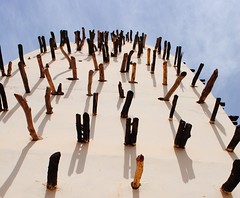From his peaceful pocket of Bamako Waou answered my question, “you want to build a ngoni? It’s very hard!”.
With a little convincing he patiently showed me how to hand build an ngoni, the grandfather of the banjo.

Step 1: Taking a large tree trunk we chopped a log to the rough size of my future ngoni’s body.
Step 2: Putting down our axes we carved out the inside to make a canoe shape and then sanded its rough surface.
Step 3: Then we drilled about 16 holes around the edge of the body before creating a groove at one end for the neck to lay.
Step 4: Cutting bamboo poles we made around 20 wooden nails.
Step 5: Then for the smelly job, we sliced the cow skin (which had soaked overnight) to the shape of the body.
Step 6: Using the bamboo nails, we stretched the skin across the body and pinned it into place.
Step 7: Using a chisel tool we carved the neck to the shape of a broom handle with a spike at one end. We then cut holes into the skin and inserted the neck of the instrument.
Step 8: We then left the whole thing to dry in the blistering 42 degree heat of the Malian sunshine. With the scorching sunshine the skin-drying only takes a few hours!
Step 9: Using a hack saw we cut off the bamboo pins to the body.
Step 10: The instrument finished, we moved onto the strings…
“What was used before nylon fishing line was available?” I ask.
“Horse hair” explains Waou, his eyes scarcely stray from his work. Remembering a story of European violin players having to hunt down cats to make strings from their guts, I tell Waou that his ancestors were far more civilised than their European counterparts.

After attaching all the strings to the instrument (six in this case), he proudly checks it over, fine tunes it and gives it a play. It is difficult to imagine that a day earlier it was little more that a log of wood, a fragment of calabash, some cow skin and a few metres of fishing line…
For all the photos, click here.













